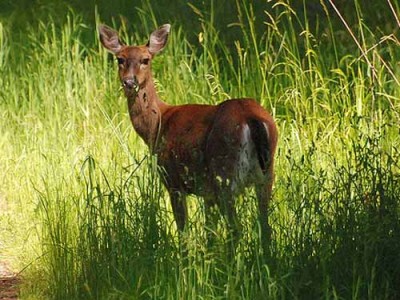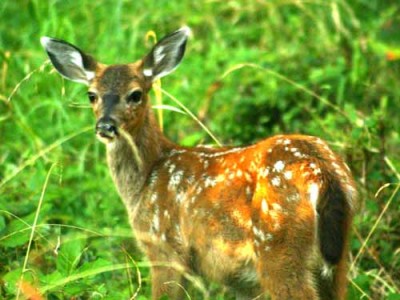Gabriola is home to a vibrant and very visible community of Black-tailed Deer. An old species, Black-tails have been around for over two million years. They are found on the coast of British Columbia and on most of the coastal islands.
Deer are browsers. During the winter and early spring they feed on Douglas fir, western red cedar, red huckleberry, salal, deer fern, and lichens that grow on trees. Late spring to fall they munch on grasses, blackberries, fireweed, pearly everlasting, forbs, salmonberry, salal, and maple. All these plants are indigenous to our island. Unfortunately as we develop our properties these plants get destroyed. We create gardens of non-native plants and flowers and the deer soon adapt to these landscapedplantings. The mating or ‘rutting’ season occurs during November and early December. Bucks can be observed running back and forth across the roads in the pursuit of does. After the rut the bucks tend to hide and rest. Often they are nursing wounds.
 They suffer broken antlers, and have lost weight. They drop their antlers between January and March. As the antlers lie on the forest floor they provide a source of calcium and other nutrients to other forest inhabitants. Bucks regrow their antlers beginning in April through to August.
They suffer broken antlers, and have lost weight. They drop their antlers between January and March. As the antlers lie on the forest floor they provide a source of calcium and other nutrients to other forest inhabitants. Bucks regrow their antlers beginning in April through to August.
The gestation period for does is six to seven months with fawns being born late May and into June. Twins are the rule although young does often have only one. Triplets can also
 Fawns weigh 2.7 to 4 kg and have no scent for the first week or so. This enables the mother to leave the fawn hidden while she goes off to browse and replenish her body after givingbirth. She must also eat enough to produce enough milk to feed her babies. Although does are excellent mothers, fawn mortality rate is 45 to 70 percent. Does are very protective of their young and humans are viewed as predators. Stay well away from a doe with young.
Fawns weigh 2.7 to 4 kg and have no scent for the first week or so. This enables the mother to leave the fawn hidden while she goes off to browse and replenish her body after givingbirth. She must also eat enough to produce enough milk to feed her babies. Although does are excellent mothers, fawn mortality rate is 45 to 70 percent. Does are very protective of their young and humans are viewed as predators. Stay well away from a doe with young.
 Deer communicate with the aid of scent and pheromones that come from several glands located on the lower legs. The metatarsal (outside of lower leg) produces an alarm scent, the tarsal (inside of hock) serves for mutual recognition and the interdigital (between the toes) leave a scent trail when deer travel. Deer have excellent sight and smell. Their large ears can move independently of each other and pick up any unusual sounds that may signal danger.
Deer communicate with the aid of scent and pheromones that come from several glands located on the lower legs. The metatarsal (outside of lower leg) produces an alarm scent, the tarsal (inside of hock) serves for mutual recognition and the interdigital (between the toes) leave a scent trail when deer travel. Deer have excellent sight and smell. Their large ears can move independently of each other and pick up any unusual sounds that may signal danger.
Dawn, dusk and moonlit nights are when we see deer browsing on the roadside. Wooded areas where there are forests on both sides of the road, open grassy areas i.e. golf course attract deer. Caution when driving is prudent because often as one deer crosses another one or two follow.
Gabriola Island is a finite space, which we share with extraordinary wild-life. Can we go one step further and protect the natural flora and fauna by planting indigenous species? Better still if there is a wild place on your property leave it as it is.

